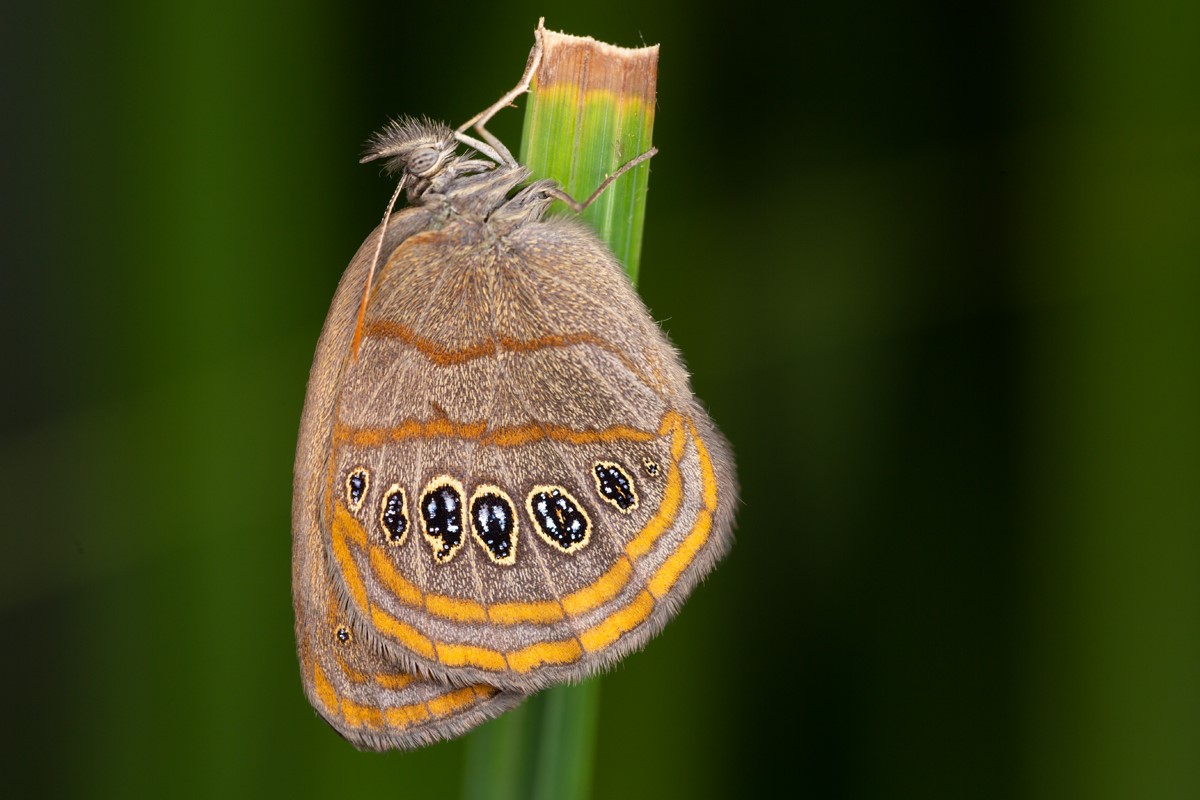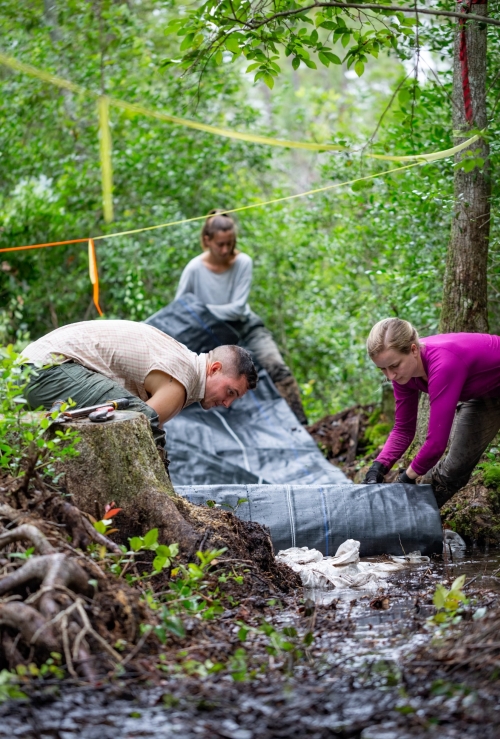Rare Butterfly Flourishes in the Most Unlikely of Environments
- Nick Haddad, Ph.D.
- Professor, Department of Integrative Biology
- College of Natural Science
- Senior Terrestrial Ecologist
- W.K. Kellogg Biological Station
Project Overview
- This project looks at restoration of the St. Francis Satyr, an endangered species of butterfly.
- The restoration process involves recreating the natural habitat in which the butterfly thrives.
Products/Outcomes
- Stabilize and grow the butterfly's population
- Remove the butterfly from the endangered species list
Partners
- Brian Ball, Staff Wildlife Biologist, Endangered Species Branch, U.S. Army
- Becky Harrison, Supervisory Wildlife Biologist, U.S. Fish and Wildlife Service
Form(s) of Engagement
- Community-Engaged Research

The endangered St. Francis Satyr is a one-inch-wide brown butterfly, with thin, rusty-red stripes, and a row of black spots.
Butterflies and bullets. Thinking of one probably won't lead to thinking of the other. Nick Haddad, professor in MSU's Kellogg Biological Station and Department of Integrative Biology, and his students are working to change that by addressing the correlation between the St. Francis Satyr butterfly and the habitats they're calling 'home.'
Haddad, a butterfly scientist and conservation biologist, was first approached by the U.S. Army in 2002 because the ideal habitat for the Satyr, ironically, lies on an artillery training zone at Fort Bragg, North Carolina - the largest army installation in the United States.
"This butterfly is one of the rarest butterflies in the world with only about 3,000 adults remaining," Haddad said. "With such a small population, it's threatened with extinction. Because of its rarity, it isn't a pollinator or an important source of food in ecosystems. However, if it is lost, so will be a large group of species in its ecosystem. Our goal is to stabilize and grow the number of butterflies both on and off the army base."
The artillery range within the installation covers 33,000 acres with the sole purpose of being a restricted space to receive ammunition, so the puzzling question remains as to why such delicate insects are thriving in an environment surrounded by 55,000 active-duty soldiers.
The answer is fire.
"During artillery training, fires are likely to break out and naturally burn through thick shrubs and trees and across wetlands," Haddad said. "The ideal habitat for the Satyrs is small, open wetlands along streams, so when fires naturally eliminate dense vegetation and burn along wetlands, they provide the ideal environment for the butterfly to thrive. If the military base wasn't there, the butterfly would now be extinct."
In addition to fire, beavers have also been an unlikely ally to the butterfly. In the past, the creation of beaver dams has assisted in the destruction of shrubs and trees along streams, allowing the butterfly's population to grow.
Haddad continued by saying that because the Satyrs have relied heavily on fires and the creation, and abandonment, of beaver dams, a reoccurring problem he and his team have seen is that these natural disturbances have been eliminated from key parts of the landscape.
Over time, safety measures and human processes have advanced, causing the occurrence of natural fires, as well as the beaver population, to diminish, ultimately reducing the populace of butterflies.

Haddad's Students Tucker Stonecypher, Madison Ohmen, and Emily Price working in the field at Fort Bragg
Crucial Partners in Restoration
As the Satyr has remained loyal to its environment at Fort Bragg, Haddad has found a long-time partner in Brian Ball, Fort Bragg's Wildlife Biologist within the Endangered Species Branch.
"Brian and his team of biologists have been invaluable," Haddad said. "Our lab does the primary science, and Brian and his team are experts in restoration."
Ball followed up, saying, "Nick and I have worked together for more than ten years, and much of that time was spent on long trips into the impact areas to survey the butterflies."
Since their initial meeting, Ball, Haddad, and their teams have worked seamlessly to stabilize the butterfly's existence.
"Our first attempt at restoration revolved around sedges, which are the butterfly's host plants," Ball said. "We cut and removed a portion of canopy and mid-story trees from a small plot to allow more sunlight to reach the ground. We also made a series of small dams to saturate the soil. In theory, this treatment should give sedges the needed light and mucky soil needed to thrive. Findings showed that sedge growth and density had increased, which was a positive sign."
As discoveries made from the surveys further advanced methodologies, Ball and Haddad began recreating natural disturbances by inserting artificial dams and manually removing thick brush to open the wetlands. They were also able to mimic habitats from the aftermath of fires on the artillery range and saw the butterfly populations recover.
"In order to succeed in restoration, we have to be the ones to do what nature would do," Haddad said.
More recently, the Army built a greenhouse on base to raise and monitor caterpillars before reintroducing them into their natural habitats around base.
Landscape Challenges
Given the delicate nature of the butterfly, and the not-so-delicate nature of weaponry training, a unique atmosphere exists within the borders of Fort Bragg.
"Working with wildlife on a military installation presents a unique set of challenges a researcher may not come across working on public lands," Ball said. "The reason Fort Bragg exists is to train the Army's soldiers. My job is to ensure training and military resources can coexist with the natural ecosystem."
Ball continued by saying another challenge surrounds the extreme rarity of the species, "When working with a species that lives on less than 200 acres worldwide, there's not a lot of room for mistakes. You have to be incredibly careful when manipulating and restoring their habitat."
Haddad agreed with Ball, adding, "There are nearly as many cottonmouth snakes as butterflies. It is frightening and exhilarating to step near a snake while tracking butterflies. This happens more often than one would like."
Satyrs Today
Haddad and Ball agree that the ultimate goal is to see the butterfly's population grow on and off the Army installation.
Additionally, if they are able to establish enough locations with stable populations, the Satyr could even be removed from the endangered species list.
In the meantime, their restoration efforts continue.
"The most exciting part of the project is to see a butterfly population thrive in a restoration area we create," Haddad said. "After we create a new habitat, butterflies either colonize the sites naturally, or we bring them in from elsewhere. After we introduce a few butterflies, to see the population take off is truly thrilling."
He continues by saying any day he gets to see the small, brown butterfly is an exciting day.
"If I look back on my life and career, I never expected to study butterflies, and now I'm the butterfly person," Haddad said.
More information related to St. Francis' Satyr, can be found in Haddad's book, The Last Butterflies: A Scientist's Quest to Save a Rare and Vanishing Creature.
The Last Butterflies spotlights Haddad's first-hand experiences in tracking these vanishing butterflies, while also exploring why they are disappearing, and why they are worth saving.
- Written by Emily Springer, University Outreach and Engagement
- Photographs courtesy of Dave Pavlik, Research Assistant, Haddad Lab